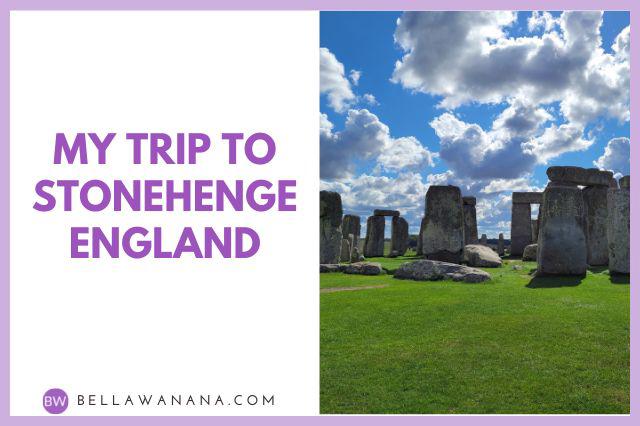In September 2022, I had the chance to visit Stonehenge in the United Kingdom. It was a beautiful experience, so I thought I would document it here!
What is Stonehenge?
Stonehenge is a prehistoric monument on Salisbury Plain in Wiltshire, England. It is a UNESCO World Heritage Site.
Stonehenge consists of an outer ring of vertical sarsen standing stones, each around 13 feet (4.0 m) high, seven feet (2.1 m) wide, and weighing around 25 tons, topped by connecting horizontal lintel stones. Inside is a ring of smaller bluestones. Inside these are free-standing trilithons, two bulkier vertical sarsens joined by one lintel. The whole monument, now ruinous, is aligned towards the sunrise on the summer solstice.
Where is Stonehenge located?
Stonehenge is located on Salisbury Plain in Wiltshire, England. It is about a two-and-a-half-hour drive from downtown London.
When was Stonehenge built?
Archaeologists believe that Stonehenge was constructed from 3000 BC to 2000 BC. This means that they were built around 4000 to 5000 years ago.
Who built Stonehenge?
Nobody knows who built Stonehenge exactly.
According to folklore, Stonehenge was created by Merlin, the wizard of Arthurian legend, who magically transported the massive stones from Ireland, where giants had assembled them. Another legend says invading Danes put the stones up, and another theory says they were the ruins of a Roman temple.
What was the purpose of Stonehenge?
There is strong archaeological evidence that Stonehenge was used as a burial site. However, scholars believe it serves other functions as well. For example, it could be a ceremonial site, a religious pilgrimage destination, or a place for royalty to spiritually connect with their ancestors.
My trip
I booked a day trip with a tour group. The trip covered the transportation both ways from downtown London to Stonehenge, a self-directed guide, and the entrance fee to the Stonehenge site.
It was a beautiful September day. It was sunny, not too hot nor too cold. I boarded the bus at around 9 am. The tour was pretty packed, full of tourists from around the world. I was sitting beside a lady from Las Vegas. She and her friends were about to board a cruise ship, and this was their little excursion before the big trip.
Once we were on the bus, we were each given a pair of earphones, a radio, and a piece of laminated paper with the map of the Stonehenge site. The back of the map had some general introduction to the Stonehenge site. The front of the map had numbers indicating various specific areas of the site. I will talk about how to use the map later.

Getting to Stonehenge was relatively easy. It was about a two-and-a-half-hour drive from downtown London. It was quite scenic along the way, so I didn’t feel bored.
The Stonehenge site
Once we got there, the first thing we saw was the visitor centre. We had to take a transit bus to go from the visitor centre to the actual site. The transit bus does come regularly, about once every 10 minutes, so it wasn’t too long of a wait.
And then we saw Stonehenge. It was magnificent. Standing in front of the prehistoric monuments, I felt insignificant. I could not help but feel the power and the ingenuity of our human ancestors presenting in front of me. The stones were not found locally, and they weighed over 25 tons each, yet somehow, our ancestors managed to transport them to the site more than 4,000 years ago.
Because Stonehenge is a popular destination for travellers and visitors, they have built a path around Stonehenge for visitors to walk on. They no longer allow access to the inside of Stonehenge, unfortunately, due to fear of damage to this magnificent prehistoric piece of engineering. However, if you follow the path, you can still have a full 360-degree view of Stonehenge and its surroundings.
There are also numbered signs around the path. When you reach each of the signs, you can use the ratio that was provided to point towards the numbers on the map, and it would play an introduction to that specific area. It was quite cool technology.

Here are some beautiful Stonehenge pictures that I took:


The exhibition centre
After coming back from the Stonehenge site, I spent some time in the Exhibition centre next to the visitor centre. The exhibition centre showcases many artifacts that were discovered in the area and provides more information about the site. What I found particularly interesting was the skeleton and the reconstruction of a man who was buried at Stonehenge thousands of years ago. There was also a video showing you the transformation of the site over time.
Outside of the exhibition centre, there were some replica Neolithic houses on display, as well as a bluestone and a sarsen stone for you to feel the weight.

The visitor centre
The visitor centre was quite nice. They had a pretty spacious dining area, and an on-site food counter where you could buy sandwiches and other food. They even had a microwave for people to heat food if they bring it themselves. There is also a gift shop and more outdoor sitting areas.
Conclusion
A visit to Stonehenge is a perfect day (or half-day) trip. It was about 4 pm when I came back to downtown London, so I still had time for a traditional British afternoon tea. I didn’t go to a particularly fancy one just because I didn’t have time to dress up, but it was still a delicious experience.

Overall, I thoroughly enjoyed my solo trip to Stonehenge. If you are in London or the surrounding areas, don’t forget to pay Stonehenge a visit.
RELATED POSTS:
